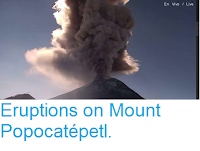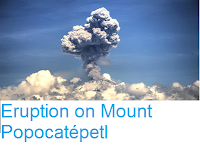Authorities in Mexico are reported to be considering evacuating communities close to Mount Popocatépetl, a stratovolcano (cone
shaped volcano made up of layers of ash and lava) in the central part of
the country, following an explosive eruption on Thursday 28 March 2019. The eruption occurred slightly before 7.50 pm local time, and produced an ash column that rose about 3 kn above the summit of the 5450 m volcano, as well as throwing incandescent material up to 2 km from the crater. This event comes as part of a trend of increasing activity on the mountain in recent months, and follows about 200 tremors in the area over the preceding 24 hours.
An ash column over Mount Popacatepetl on Thursday 28 March 2019. Webcams de Mexico/Centro Nacional de Prevención de Desastres.
Popocatépetl has been more or less constantly erupting since the mid
1990s, but most of the time this activity remains at a low level. Major
eruptions on Popocatépetl are a cause for concern as the volcano
is in a densely populated area, with 30 million people living within the
potential hazard zone. The last major eruption, a Plinian (or Vesuvian)
event in about 800 AD, triggered a series of pyroclastic flows and
lahars that scoured the basins around the volcano.
The location of Popocatépetl. Google Maps.
The volcanoes of the Trans-Mexican Volcanic Belt (including
Popocatépetl) are fuelled by the subduction of the Cocos Plate beneath
the North American Plate along the Middle American Trench to the south
of Mexico. As the subducting plate sinks into the Earth it is melted by
the heat and pressure, and volatile minerals liquefy and rise through
the overlying North American Plate as magma, fuelling Mexico's volcanoes.
The subduction of the Cocos Plate beneath the North American Plate in Mexico, and how it leads to volcanoes and Earthquakes. King Saud University.
See also...
Follow Sciency Thoughts on Facebook.









